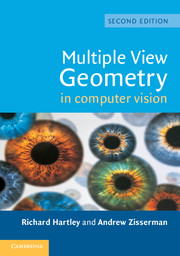Book contents
- Frontmatter
- Contents
- Foreword
- Preface
- 1 Introduction – a Tour of Multiple View Geometry
- PART 0 The Background: Projective Geometry, Transformations and Estimation
- PART I Camera Geometry and Single View Geometry
- PART II Two-View Geometry
- PART III Three-View Geometry
- 15 The Trifocal Tensor
- 16 Computation of the Trifocal Tensor T
- PART IV N-View Geometry
- PART V Appendices
- Bibliography
- Index
15 - The Trifocal Tensor
Published online by Cambridge University Press: 25 January 2011
- Frontmatter
- Contents
- Foreword
- Preface
- 1 Introduction – a Tour of Multiple View Geometry
- PART 0 The Background: Projective Geometry, Transformations and Estimation
- PART I Camera Geometry and Single View Geometry
- PART II Two-View Geometry
- PART III Three-View Geometry
- 15 The Trifocal Tensor
- 16 Computation of the Trifocal Tensor T
- PART IV N-View Geometry
- PART V Appendices
- Bibliography
- Index
Summary
The trifocal tensor plays an analogous role in three views to that played by the fundamental matrix in two. It encapsulates all the (projective) geometric relations between three views that are independent of scene structure.
We begin this chapter with a simple introduction to the main geometric and algebraic properties of the trifocal tensor. A formal development of the trifocal tensor and its properties involves the use of tensor notation. To start, however, it is convenient to use standard vector and matrix notation, thus obtaining some geometric insight into the trifocal tensor without the additional burden of dealing with a (possibly) unfamiliar notation. The use of tensor notation will therefore be deferred until section 15.2.
The three principal geometric properties of the tensor are introduced in section 15.1. These are the homography between two of the views induced by a plane back-projected from a line in the other view; the relations between image correspondences for points and lines which arise from incidence relations in 3-space; and the retrieval of the fundamental and camera matrices from the tensor.
The tensor may be used to transfer points from a correspondence in two views to the corresponding point in a third view. The tensor also applies to lines, and the image of a line in one view may be computed from its corresponding images in two other views. Transfer is described in section 15.3.
Information
- Type
- Chapter
- Information
- Multiple View Geometry in Computer Vision , pp. 365 - 390Publisher: Cambridge University PressPrint publication year: 2004
Accessibility standard: Unknown
Why this information is here
This section outlines the accessibility features of this content - including support for screen readers, full keyboard navigation and high-contrast display options. This may not be relevant for you.Accessibility Information
- 1
- Cited by
